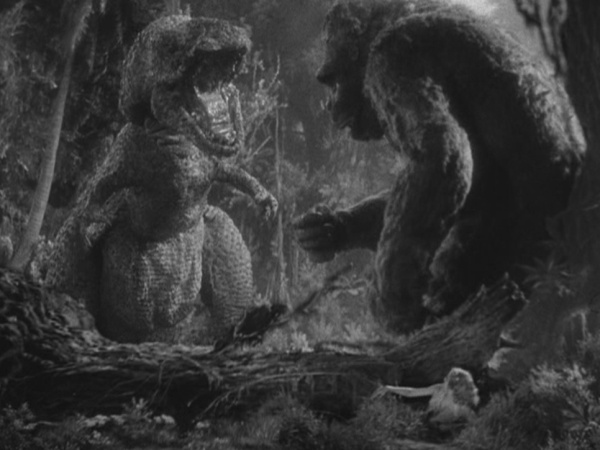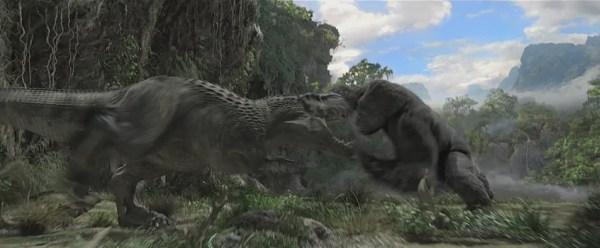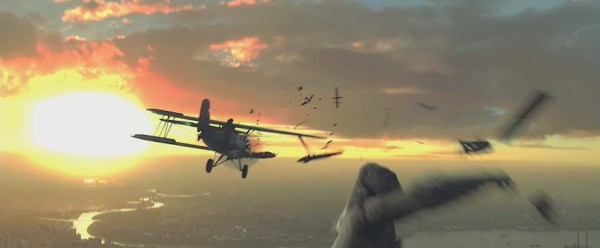King Kong (Merian C. Cooper & Ernest B. Schoedsack, 1933) and
King Kong (Peter Jackson, 2005)
If you ever wanted to be reassured that it’s okay to like big special effects blockbusters, have a look at the reputation of the 1933 version of King Kong. The film is a solid, rolled-gold classic, and makes a strong showing in any of the dubious-but-fun movie popularity contests: it is in the American Film Institute’s Top 100 List; Christopher Tookey’s The Critics Film Guide cites it has having an average critical rating of 9.53 out of 10; the Internet Movie Database has it in its top 250 user-rated films; and so on. Received wisdom is a wonderful thing: once a film is a famous classic, and several decades old, it is easy to accept its status, and not think about why the film is so revered. Yet with King Kong it pays to ask the question. For the original King Kong is a forerunner to all the light-on-plot, big-on-special-effects blockbusters of recent years: as such, its continuing fame is something of a challenge to conventional critical wisdom, which tends to be dismissive of this kind of filmmaking.
I’m not saying it is not deserving of its reputation: far from it. Yet there is no doubt that there is a double standard here. Those who thoughtlessly dismiss the blockbusters of recent years as some new-found dumbing-down of the cinema forget that the artform was built on films like this. Cinema, right from the start, was split between competing artistic sensibilities, neatly embodied by two of its earliest practicioners: the Lumiere brothers, who made “actuality films” depicting everyday scenarios such as workers leaving their factory; and Georges Méliès, who saw film as essentially a giant magic act, and set about using the technology to depict the impossible. Critical preference for the former tradition goes back to early film critics and theorists such as André Bazin and Siegfried Kracauer, who advocated film techniques that interfered with the depiction of the real as little as possible. Yet it is from the Méliès-inspired tradition from which King Kong derives, and it is a reminder that cinema remains an artform particularly suited to grand displays of showmanship. Its classic status shows that no matter how much critics might try to shape canons in other directions, the public’s embrace of films that thrill them and show them something new can still push a fairly simple monster movie into the pantheon.
Over the years, critics have responded gamely to the continuing popuylarity of King Kong by attempting to re-imbue the film with depth, offering various interpretations that reconfigure the relatively mundane narrative into a modern myth. For example, Danny Peary, in his book Cult Movies, argues that the giant ape Kong is a predecessor of the Id Monster from Fantastic Voyage: a representation of the subconscious lust that filmmaker Carl Denham (Robert Armstrong) feels for his heroine Ann Darrow (Fay Wray). Others have painted the film as an expression of racist sentiment, with Kong acting as a fantasised representative of the native tribe, stealing away white women. (“Blondes are scarce around here,” notes Denham.) Yet, as a rule, I generally don’t find such psychoanalytic or structuralist interpretations of films terribly convincing in the absence of some concrete evidence that the filmmakers intended the reading, simply because such interpretations can be built around almost any film.
This is particularly the case for a film as unpretentious as King Kong. While I do think the screenwriters came up with an excellent scenario (there is all sorts of resonance in both the lost island idea, and in the forced relocation of Kong to civilization in the final act) there is no getting around the fact that the general level of acting and dialogue is that of a B-movie. There is, after all, the distinct whiff of a high school play in the film’s awkward characterisation and clunky attempts at exposition. For example, the key romantic subplot of the film reaches its climax in this exchange between Darrow and the misogynist ship’s mate, Jack Driscoll (Bruce Cabot):
Jack Driscoll: “When I think what might have happened today… If anything had happened to you –”
Ann Darrow: ” Well then you wouldn’t be bothered with another woman on board.” (She laughs awkwardly).
Jack Driscoll: “Don’t laugh. I’m scared for you. I’m sort of – well, I’m scared of you too. Ann, uh, I, uh…. Say – I guess I love you!”
Ann Darrow: “Why Jack! You hate women!”
Jack Driscoll: “Yeah, I know. But you aren’t women. Say, Ann, I don’t suppose, uh… I mean, well, you don’t feel anything like that about me, do you?”
They kiss.
Even this early in the era of talking pictures, this wasn’t top-drawer romantic dialogue. Whatever kind of subtext you put on it, King Kong is just a big dumb monster movie, an example of the kind of brainless special effects extravaganza that has been ruining the movies for a century now.
Which brings us to the real star of the movie: Willis O’Brien’s special effects. The film can’t really be hailed as a breakthrough technologically – it built fairly incrementally on O’Brien’s animation in The Lost World (1925) – but it did take the critical step of establishing Kong as a stop-motion character, rather than simply a beast. While the effects are obviously dated, and the stop-motion technique has an inherently fake-looking quality to it, O’Brien’s work remains impressive. There are various little touches throughout that show Kong’s intelligence, such as the way he curiously opens and closes the limp jaw of a dinosaur he has just killed (a touch echoed in Peter Jackson’s remake). It is O’Brien’s animation, more than anything else, that is responsible for Kong’s cultural status as a tragic hero.
Nobody else involved in the production, after all, seems to have had any intention that we empathise with Kong. He kills a lot of people, Ann Darrow screams and / or faints every time he is near, and it is the heroes of the movie who dream up the notion of killing him with aircraft. While there are some plot elements that make us feel for Kong, these seem to have been inadvertent. For example, Kong fights a series of battles with monsters on the island: by default, Kong becomes Ann’s protector, which means we root for him. Yet the scenes seem to be there simply to add spectacle, and Darrow never shows any sign that she feels much safer around Kong than the other animals. Similarly, when Kong is imprisoned and humiliated in New York, we feel sorry for him. Yet such a response doesn’t seem to have occurred to the filmmakers: Ann and Jack show no sign of pity for Kong, and cheerfully endorse Carl Denham’s financial exploitation of his captivity. Even when Kong dies, and uses his last living moments to place Darrow in a safe place, Darrow doesn’t acknowledge the gesture. The audience embrace of Kong occurs, then, in defiance of the script, and this is attributable mainly to O’Brien’s success in bringing Kong to life as a living creature.
By contrast, empathy with Kong is the jumping-off point for Peter Jackson’s 2005 remake (the second, following a 1976 version directed by John Guillerman). Jackson and his co-writers (Fran Walsh and Philippa Boyens) have expanded the story somewhat, fleshing out the supporting characters, but the key change is to play up Kong’s status as doomed outsider, and to make the film into a pseudo-romantic tragedy. Ann Darrow (Naomi Watts) is no longer oblivious to either the heroics or the suffering of Kong, while his exploiter, Carl Denham (Jack Black) has gone from the original’s benign Barnum-esque figure to a deliciously cynical villain (a role that Black clearly relishes). Generally the changes are smartly done, adding depth, colour and scope to the movie. Where the original’s characterisation was pared back to the point of being comical, Jackson’s film bursts with supporting characters and subplots, while the one-on-one animated skirmishes of the original have given way to enormous action setpieces using state-of-the-art CGI. The resulting film is a tad overlong (Jackson probably needed to make a hard decision and lose an action sequence form the middle of the film), but it’s still grand entertainment.
The change to the character of Kong means that, even more than in the original, the realisation of Kong is critical. The animators at Weta Digital, working from a reference performance by Andy Serkis, therefore deserve enormous credit for their work on Kong, which sets a new benchmark for believability and character animation in a computer animated feature. Kong is superb on three levels: he is never less than completely real in his incorporation in the film’s environments; he is constantly and believably gorilla-like; and he is convincingly endowed with feelings and personality. The scenes between Watts’ Darrow and Kong are the heart of the film, and they are brilliantly played. Kong is made sympathetic without being anthropomorphised, and Darrow’s bond with him is developed sensibly, without descending into foolishness. When Kong is imprisoned, it’s deeply sad, and when he runs amok, you understand the rage, fright and bewilderment he feels.
Jackson doesn’t let the retooling of the film as a tragedy bog it down, however. The Skull Island portion of the film is almost ludicrously overstuffed with action setpieces involving the animated creatures. As I wrote when I saw a preview version of one of these sequences, the continually escalating scale of creature films means that these sequences are becoming progressively more over-the-top. Jackson has responded by coming up with outrageous concepts for his creature sequences: one has brontosauruses stampeding down a canyon, only to fall over and tumble toward our heroes like the boulder in Raiders of the Lost Ark; another has dinosaurs fighting with Kong while suspended from vines. These sequences move beyond the need for believability, working because their outlandishness brings its own inherent humour. They also push the envelope of what the effects can convincingly achieve. Sometimes (as in the T-Rex sequence) the effects people meet the goal, while in other sequences (the dinosaur stampede) they fall a little short. Yet the film is always exciting, and occasionally – as in the sequences with the natives, or the “spider-pit” sequence – quite scary.
Jackson’s reverence of the original is revealed by countless small touches. Early in the film, when Denham is searching for his leading lady, he contemplates “Fay” but is told she is off working on a picture with “Cooper.” Later, the film recycles the costumes and dance moves from the original’s scenes with the native tribe for Denham’s hokey stage performance. Even the animation has echoes: when Kong kills the T-Rex, he curiously opens and closes its lifeless jaws, just as O’Brien’s Kong did. At other points, dialogue (including the closing lines) is reworked word-for-word or very close to it. My favourite such moment is one tip of the hat that shows Jackson is clear-headed about the weaknesses of his source: at one point, the awful romantic dialogue from the original turns up in the movie-within-a-movie that Denham is shooting, and is attributed to script rewrite by the lead actor.
Throughout, I was impressed by the thoughtfulness of Jackson’s take on King Kong. Every change he makes is for the better, and there is the feel that you’re finally seeing the potential of the premise realised. He deepens the relationships between characters, neatly sidesteps the story’s racist overtones (the native tribe is almost de-ethnicised, with an unnatural skin tone and a zombie-like appearance), and broadens the scope of the action. He shifts the role of villain from Kong to Denham, where it belongs. The film’s final sequences show off a tremendous recreation of 1930s New York (partly physical, partly digital), and finally realises the grandeur of the iconic scene where Kong ascends the Empire State Building. While I would like to see Jackson attempt something a little snappier and less epic next time (just to prove he can still do it), his King Kong is Hollywood filmmaking at its best.


